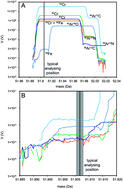Precise measurement of chromium isotopes by MC-ICPMS
Abstract
We report novel analytical procedures allowing for the concurrent determination of the stable and mass-independent Cr isotopic composition of silicate materials by multiple collector inductively coupled mass spectrometry (MC-ICPMS). In particular, we focus on improved precision of the measurement of the neutron-rich isotope 54Cr. Because nitride and oxide interferences are a major obstacle to precise and accurate 54Cr measurements by MC-ICPMS, our approach is designed to minimize these interferences. Based on repeat measurements of standards, we show that the mass-independent 53Cr and 54Cr compositions can be routinely determined with an external reproducibility better than 2.5 and 5.8 ppm (2 sd), respectively. This represents at least a two-fold improvement compared to previous studies. Although this approach uses significantly more Cr (30–60 μg) than analysis by thermal ionization mass spectrometry (TIMS), our result indicate that it is possible to obtain an external reproducibility of 19 ppm for the μ54Cr when consuming amounts similar to that typically analyzed by TIMS (1 μg). In addition, the amount of time required for analysis by MC-ICPMS is much shorter thereby enabling a higher sample throughput. As a result of the improved analytical precision, we identified small apparent mass-independent differences between different synthetic Cr standards and bulk silicate Earth (BSE) when using the kinetic law for the mass bias correction. These differences are attributed to the Cr loss by equilibrium processes during production of the synthetic standards. The stable isotope data concurrently obtained have a precision of 0.05‰ Da−1, which is comparable to earlier studies. Comparison of the measured isotopic composition of four meteorites with published data indicates that Cr isotope data measured by the technique described here are accurate to stated uncertainties. The stable Cr composition of the Bilanga and NWA 2999 achondrites suggests that the differences in the stable Cr isotope composition of Earth and chondrites may reflect heterogeneity of their precursor material rather than Cr isotope fractionation during metal–silicate segregation of Earth. Lastly, a step wise dissolution experiment of the CI chondrite Ivuna reveals previously unknown carriers of large mass-dependent Cr stable isotope variations that co-vary with the known presence of carriers of large nucleosynthetic anomalies, demonstrating one advantage of this technique.


 Please wait while we load your content...
Please wait while we load your content...